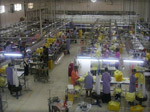Great disparities remain between the productive performance of countries in the MENA zone. A study carried out by FEMISE highlighted the delay in the region compared to major developing countries, with the clear exception of Morocco.
Before we can talk about regional integration or integration towards the north, the countries in the MENA region (Middle East and North Africa) must improve their own positioning, notably in terms of international competitiveness.
In a very detailed study (FEM33-09) of industrial systems in the region, the Centre d’Études et de Recherche sur le Développement International (CERDI) (Centre for Research into International Development) highlighted a series of stumbling blocks. Some well-known differences between one country and another, such as in the textile sector for example, were highlighted. Between Lebanon and Morocco, company productivity ranges from $1,780 per head to $10,610. Algeria ranks better than Egypt with $4,270 per head compared to $3,470. By means of comparison, these figures were $11,350 for China over the same period (2000-2004) and $10,480 in India.
Of course, due to a lack of homogenous and, in particular, a lack of recent data, the results of this study (which concentrates on these four MENA countries), are to be interpreted with caution. But on the whole, its conclusions are telling: at least over the first half of the decade, the Moroccan manufacturing sector was by far the most effective and “its performance is fairly similar to that of higher developing countries such as South Africa or Brazil and somewhat better than that of China or India”.
The weight of public administration
To explain this delay, the study puts a particular emphasis upon wage gaps. The unit cost of labour in the MENA zone is $540, compared to $390 in the extra-MENA countries studied (China, India etc). In sectors which employ as many people as the textile and clothing industries, Egypt and Morocco are 2 to 2.5 times more expensive than India. Hence the need to act quickly, otherwise “their competitiveness will suffer from the rate of innovation and technological catch-up in Asia which is greater than the rate at which the cost of labour is growing, allowing them to bridge the gap in the quality of products.”
As for disparities within the MENA zone, the study mentions the “quality of the business climate”. In Morocco, openness towards foreign markets, measured by the rate at which goods are exported or with which foreign companies invest business capital, allows for better funding and above all provides local companies with opportunities in other markets. In Egypt, Algeria and Lebanon, it is institutions which slow down business. Public administration is often corrupt and provides poor public services (electricity, telephone …). The result is that while an importer can hope to have their goods available within 2-6 days in Morocco, they have to wait 15-26 days in Algeria … And in Lebanon, State weaknesses are a barrier to incoming companies which have to account for the additional costs of poor government.
Article by Brigitte Challiol, from the website Econostrum. It belongs to a series of articles that will be published in the context of the partnership between Econostrum and Femise for the year 2010. These articles will also feed the “Mediterranean Reflection” part of the Econostrum Website. You can find this topic and all information at the following address:www.econostrum.info. Registration for the Econostrum newsletter is available here: http://www.econostrum.info/subscription/


